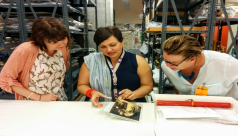ROM Research
Monthly Archive: December rom
True Blue Detectives
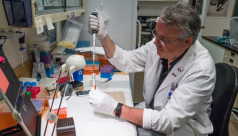
Guest blog written by 2017 Environmental Visual Communication student Connor McDowell
The Royal Ontario Museum has marked yet another first for science with the Blue Whale Project. This achievement could hold keys to the conservation of this majestic, endangered mammal – not to mention a deeper understanding of the unique evolutionary history of the largest living animal on Earth. The beginning of this story starts two thousand kilometers away, on the shores of Newfoundland, Canada with something so small that you can't see it with the naked eye.
The Woman Behind the Biggest Heart in the World

Guest Blog written by 2017 Environmental Visual Communication student Fenella Hood
Knife in hand and knee-deep in rotting blubber, Jacqueline Miller is about to do something that has never been done before: carve out a blue whale's heart for preservation. Enveloped in its stench and racing against decay, she cuts deep into the tissue beneath, sure in her knowledge of anatomy but ever wondering: Will this even work? Read on to learn more about one of the team members behind the world's biggest heart in this blog by EVC student Fennella Hood.
Tokummia, a new fossil species from the Burgess Shale traces origin of ants, millipedes and lobsters.
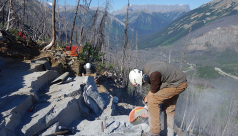
Guest Blog by Cédric Aria, recent PhD graduate from Dept. of Ecology and Evolutionary, UofT, who was based at the ROM. Currently a post-doctoral researcher at the Nanjing Institute of Geology and Palaeontology.
Wildlife Photography: Behind the Camera
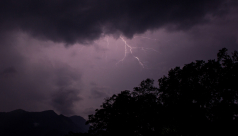
Guest Blog written by Environmental Visual Communication students Aisha Parkhill-Goyette and Jeff Dickie
Imagine you are deep in the jungle of Sri Lanka. You find yourself blinded by the pouring rain, knee deep in a rushing river, desperately trying not to fall in. Lightning strikes only meters away, but instead you are worried about the small tickle by your left elbow, and you are hoping that it is not one of the dozens of land leeches that keep falling onto you from the trees above. Not everyone has what it takes to be a wildlife photographer. It takes a special kind of dedication and a special kind of person - someone who is just as wild as the creatures they are trying to capture on camera.
EVC Students Jeff and Aisha interviewed a pair of up-and-coming wildlife photographers who travelled with ROM mammalogist Burton Lim to Sri Lanka last fall, to share some stories about what it's like behind the camera.
Blue Whale Update: From Trenton with Love
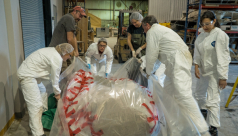
It’s that time of year where many of us are pretty focused on the holidays. Spending time with family and friends, baking and eating loads of treats, and - let’s be honest - the gifts. Finding them, buying them, wrapping them, and getting them to where they need to go, whether the destination is under the Christmas tree, or to be mailed to relatives somewhere else around the world.
So, given that everybody’s in this present-logistics state of mind, we have a gift-wrapping question for you… how do you ship a blue whale heart?
The ROM's Very Own Batman Returns
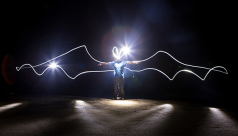
ROM Biodiversity (@ROMBiodiversity) was in the fields and forests of Sri Lanka for an intense four weeks between Aug 23 - Sept 19, 2015, completing the first comprehensive survey of bats and other small mammals that live on the island in close to 80 years.
ROM in the Field: Bats, Barcoding, and a Baby
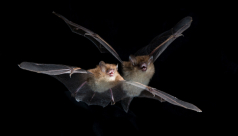
ROM Biodiversity (@ROMBiodiversity) is in the fields and forests of Sri Lanka for an intense four weeks doing the first comprehensive survey of bats and other small mammals in close to 80 years. Follow the South Asian adventure on social media with #ROMSriLanka, and join Burton Lim and the Team LIVE from the field on September 10 at noon: https://www.rom.on.ca/en/activities-programs/events-calendar/hangout-with-our-rom-biodiversity-team-in-sri-lanka
#ROMSriLanka Kicks off Month-long Expedition
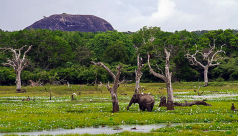
Guest blog written by #ROMSriLanka Communication team member Deirdre Leowinata
The ROM’s own Assistant Curator of Mammalogy, Burton Lim, along with his ROM Biodiversity team, are traversing the planet’s surface to reach the small and mysterious country of Sri Lanka between August and September for one purpose and one purpose only… to study the island's small mammals.
The Monastery of St Moses, Syria: The Prehistoric Remains
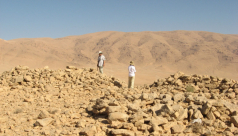
Since 2004 I had walked the Qalamoun mountains around the monastery of Deir Mar Musa looking for archaeological features to record. In all that time I found one lithic, a stone tool from humanity’s prehistoric past. My colleagues back home that specialised in these objects would say that I just didn’t know what I was looking for. In the last days of the 2009 season, what turned out to be my last season at the monastery, I thought I would reconnoitre the southern part of the field area.
- 1
- 2

